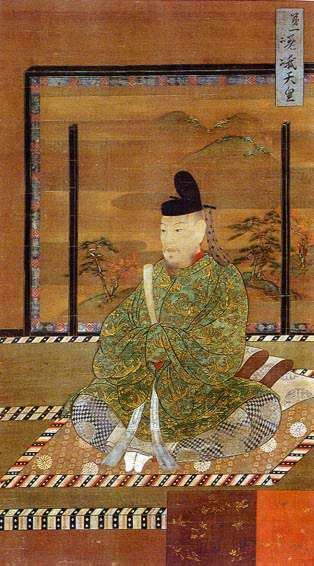Name Emperor Saga Died August 24, 842 AD | Siblings Emperor Heizei | |
 | ||
Reign 18 May 809 – 23 May 823 Burial February 24, 1989Saga no yamanoe no misasagi Children Emperor Ninmyo, Princess Seishi Parents Fujiwara no Otomuro, Emperor Kanmu Similar People Emperor Kanmu, Emperor Seiwa, Emperor Jimmu | ||
Brave frontier jp emperor saga schiff
Emperor Saga (嵯峨天皇, Saga-tennō, (October 10, 786 – August 24, 842) was the 52nd emperor of Japan, according to the traditional order of succession. Saga's reign spanned the years from 809 through 823.
Contents
- Brave frontier jp emperor saga schiff
- Final fantasy record keeper emperor saga collaboration
- Traditional narrative
- Events of Sagas life
- Eras of Sagas reign
- Legacy
- Kugy
- Consorts and children
- References
Final fantasy record keeper emperor saga collaboration
Traditional narrative
Saga was the second son of Emperor Kanmu and Fujiwara no Otomuro. His personal name was Kamino (神野). Saga was an "accomplished calligrapher" able to compose in Chinese who held the first imperial poetry competitions (naien). According to legend, he was the first Japanese emperor to drink tea.
Saga is traditionally venerated at his tomb; the Imperial Household Agency designates Saganoyamanoe no Misasagi (嵯峨山上陵, Saganoyamanoe Imperial Mausoleum), in Ukyō-ku, Kyoto, as the location of Saga's mausoleum.
Events of Saga's life
Soon after his enthronement, Saga himself took ill. At the time the retired Heizei had quarreled with his brother over the ideal location of the court, the latter preferring the Heian capital, while the former was convinced that a shift back to the Nara plain was necessary, and Heizei, exploiting Saga's weakened health, seized the opportunity to foment a rebellion, known historically as the Kusuko Incident; however, forces loyal to Emperor Saga, led by taishōgun Sakanoue no Tamuramaro, quickly defeated the Heizei rebels which thus limited the adverse consequences which would have followed any broader conflict. This same Tamuramaro is remembered in Aomori's annual nebuta or neputa matsuri which feature a number of gigantic, specially-constructed, illuminated paper floats. These great lantern-structures are colorfully painted with mythical figures; and teams of men carry them through the streets as crowds shout encouragement. This early ninth century military leader is commemorated in this way because he is said to have ordered huge illuminated lanterns to be placed at the top of hills; and when the curious Emishi approached these bright lights to investigate, they were captured and subdued by Tamuramaro's men.
Eras of Saga's reign
The years of Saga's reign are more specifically identified by more than one era name (nengō).
Legacy
In ancient Japan, there were four noble clans, the Gempeitōkitsu (源平藤橘). One of these clans, the Minamoto clan are also known as Genji (源氏), and of these, the Saga Genji (嵯峨源氏) are descended from 52nd emperor Saga. Saga's grandson, Minamoto no Tōru, is thought to be an inspiration for the protagonist of the novel The Tale of Genji.
In the 9th century, Emperor Saga made a decree prohibiting meat consumption except fish and birds and abolished capital punishment in 818. This remained the dietary habit of Japanese until the introduction of European dietary customs in the 19th century.
Emperor Saga played an important role as a stalwart supporter of the Buddhist monk Kūkai. The emperor helped Kūkai to establish the Shingon School of Buddhism by granting him Tō-ji Temple in the capital Heian-kyō (present-day Kyoto).
Kugyō
Kugyō (公卿) is a collective term for the very few most powerful men attached to the court of the Emperor of Japan in pre-Meiji eras.
In general, this elite group included only three to four men at a time. These were hereditary courtiers whose experience and background would have brought them to the pinnacle of a life's career. During Saga's reign (809–823), this kugyō included:
Consorts and children
Saga had 49 children by at least 30 different women. Many of the children received the surname Minamoto, thereby removing them from royal succession.
Empress: Tachibana no Kachiko (橘嘉智子) (786–850), also known as Empress Danrin (檀林皇后, Danrin-kōgō), daughter of Tachibana no Kiyotomo (橘清友).
Hi (deposed): Princess Takatsu (高津内親王) (d. 841), daughter of Emperor Kanmu
Hi: Tajihi no Takako (多治比高子) (787–825), daughter of Tajihi no Ujimori (多治比氏守)
Bunin: Fujiwara no Onatsu (藤原緒夏) (d. 855), daughter of Fujiwara no Uchimaro (藤原内麻呂)
Nyōgo: Ōhara no Kiyoko (大原浄子) (d. 841), daughter of Ōhara no Yakatsugu (大原家継)
Nyōgo: Princess Katano (交野女王), daughter of Prince Yamaguchi (山口王)
Nyōgo: Kudara no Kimyō (百済貴命) (d. 851), daughter of Kudara no Shuntetsu (百済俊哲)
Koui: Iidaka no Yakatoji (飯高宅刀自)
Koui: Akishino no Koko (秋篠高子/康子), daughter of Akishino no Yasuhito (秋篠安人)
Koui: Yamada no Chikako (山田近子)
Court lady (Naishi-no-kami): Kudara no Kyomyō (百済慶命) (d. 849), daughter of Kudara no Kyōshun (百済教俊)
Court lady: Takashina no Kawako (高階河子), daughter of Takashina no Kiyoshina (高階浄階)
Court lady: Fun'ya no Fumiko (文屋文子), daughter of Fun'ya no Kugamaro (文屋久賀麻呂)
Court lady: A daughter of Hiroi no Otona (広井弟名の娘)
Court lady: Fuse no Musashiko (布勢武蔵子)
Court lady: A daughter of Kamitsukeno clan (上毛野氏の娘)
Court lady(Nyoju): A daughter of Taima no Osadamaro (当麻治田麻呂の娘)
Court lady: A daughter of Abe no Yanatsu (安部楊津の娘)
Court lady: Kasa no Tsugiko (笠継子), daughter of Kasa no Nakamori (笠仲守)
Court lady: A daughter of Tanaka clan (田中氏の娘)
Court lady: A daughter of Awata clan (粟田氏の娘)
Court lady: Ōhara no Matako (大原全子), daughter of Ōhara no Mamuro (大原真室)
Court lady: A daughter of Koreyoshi no Sadamichi (惟良貞道の娘)
Court lady: A daughter of Nagaoka no Okanari (長岡岡成の娘)
Court lady: A daughter of Ki clan (紀氏の娘)
Court lady: Kura no Kageko (内蔵影子)
Court lady: Kannabi no Iseko (甘南備伊勢子)
Court lady: Tachibana no Haruko (橘春子)
Court lady: Ōnakatomi no Mineko (大中臣峯子)
(from unknown women)
